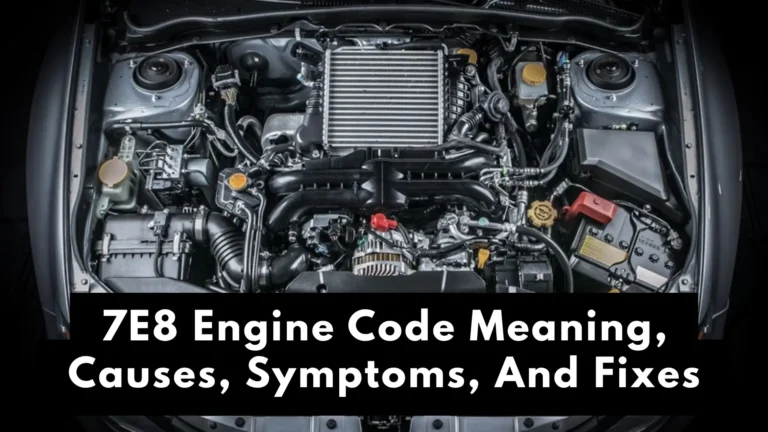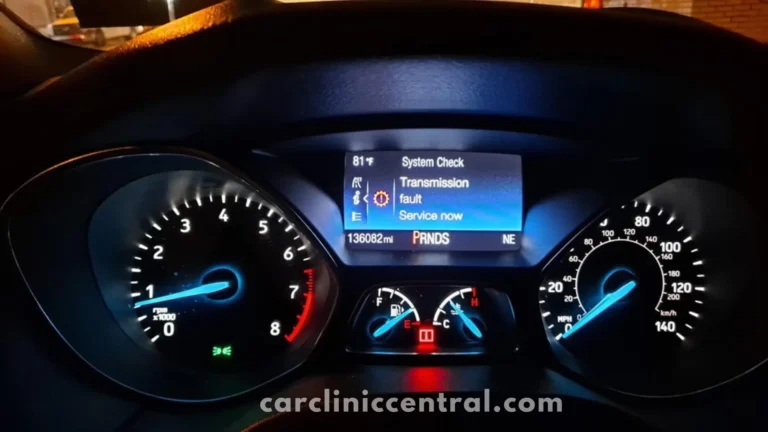7EA Engine Code: Causes, Diagnosis, and Solutions [2025]
Are you seeing the 7EA engine code in your Chevy’s dashboard? This common issue can leave drivers feeling puzzled and anxious about their vehicle’s performance. Understanding what this code means is crucial for maintaining your car’s health and ensuring a smooth ride.
Whether you’re a seasoned mechanic or just beginning to learn about engine codes, we’ll break down everything you need to know about the 7EA engine code—its causes, how to diagnose it, potential repairs, and troubleshooting tips. Buckle up as we navigate through this essential guide!
Common Causes of the 7EA Engine Code
The 7EA engine code typically signals issues related to the vehicle’s performance and emissions. One of the most common culprits is a malfunctioning oxygen sensor. When this sensor fails, it disrupts the air-fuel mixture, leading to poor combustion.
Another frequent cause is a faulty fuel injector. If an injector isn’t delivering the right amount of fuel to the engine, it can trigger this warning code.
Vacuum leaks are also worth mentioning. A leak in any vacuum line can result in erratic engine behavior and may lead to activating the 7EA code.
Problems with ignition components like spark plugs or coils might contribute as well. These parts play a crucial role in ensuring your engine runs smoothly; when they falter, you could see that pesky code pop up again.
How to Diagnose the 7EA Engine Code
Diagnosing the 7EA code requires a systematic approach. Start by connecting an OBD-II scanner to your vehicle’s diagnostic port. This will pull up any trouble codes stored in the ECU, including the elusive 7EA.
Once you’ve identified the code, take note of other related codes that may appear alongside it. These can provide valuable clues about underlying issues affecting your engine’s performance.
Next, check for any visible signs of wear or damage in components associated with the code. Inspect wiring harnesses for fraying and connectors for corrosion.
It’s also wise to review recent repairs or maintenance work done on your Chevy. Sometimes, even minor changes can trigger error codes unexpectedly.
Consult service manuals specific to your model year for deeper insights into potential causes tied directly to the 7EA engine code.
Step-by-Step Diagnostic Process for the 7EA Code
Begin by connecting an OBD-II scanner to your vehicle’s diagnostic port. This tool will read the trouble codes, including the 7EA engine code.
Next, take note of any additional codes that appear alongside 7EA. They might point to related issues needing attention.
After collecting this information, visually inspect key components like wiring harnesses and connectors associated with the affected systems. Look for signs of wear or damage.
Then move on to checking specific sensors linked to the 7EA code. Testing their voltage and resistance can help identify faulty parts.
If necessary, conduct a smoke test to check for vacuum leaks in intake or exhaust systems—often culprits behind many error codes.
Ensure that all software updates are current as outdated firmware can trigger false readings. Follow these steps carefully for accurate diagnostics tailored towards resolving the 7EA engine code effectively.
7EA Code Repair: Fixing the Problem
Repairing the 7EA engine code requires a careful approach. Start by gathering the right tools and materials for your specific vehicle model. This ensures you have what you need at hand.
Check all related components, particularly sensors and wiring harnesses. Faulty connectors can often lead to this error code appearing in your Chevy.
Once you’ve identified the problem area, replace any damaged parts with high-quality replacements. It’s crucial to use OEM or reputable aftermarket components for lasting results.
After making repairs, run a diagnostic test again to verify that the issue is resolved. If everything checks out, proceed with resetting the system as outlined in your vehicle’s manual.
Always monitor performance post-repair. Keeping an eye on how your engine runs can prevent future issues related to the 7EA code from surfacing again anytime soon.
How to Reset the 7EA Engine Code
Resetting the 7EA engine code can be a straightforward process. Start by ensuring your vehicle is parked safely and powered off.
![7EA Engine Code: Causes, Diagnosis, and Solutions [2025] 2 How to Reset the 7EA Engine Code](https://carcliniccentral.com/wp-content/uploads/2025/09/How-to-Reset-the-7EA-Engine-Code-1024x576.webp)
Next, locate the OBD-II port under your dashboard. Using an OBD-II scanner, connect it to this port. Once connected, turn on the ignition without starting the engine.
Navigate through the scanner’s menu until you find options for reading or clearing codes. Select “Clear Codes” or a similar option related to resetting.
After successfully resetting, disconnect the scanner and take your car for a short drive. This allows all systems to recalibrate and ensures that any underlying issues remain addressed.
If the 7EA code reappears after reset, further diagnosis may be necessary to identify persistent problems within your vehicle’s system. Regular monitoring helps maintain optimal performance while preventing damage down the line.
Can the 7EA Code Cause Engine Damage?
The 7EA engine code can definitely raise concerns among vehicle owners. Ignoring this code might lead to more significant issues down the road. While it’s not a direct signal of impending engine failure, it indicates underlying problems that need attention.
For instance, if related issues like fuel delivery or sensor malfunctions persist without being addressed, they could create stress on your engine components. This stress may result in decreased performance and efficiency over time.
Regularly monitoring and resolving the causes behind the 7EA code is essential for maintaining optimal engine health. Catching these problems early can prevent costly repairs later on.
Always remember that proactive maintenance is key to keeping your vehicle running smoothly and efficiently. Don’t let a simple error code snowball into major damage; take action when you see the 7EA light illuminate on your dashboard.
Related Articles:
Mercedes-Benz ESP Inoperative
Mazda Battery Management System Malfunction
7EA Code Troubleshooting Tips
When dealing with the 7EA engine code, a systematic approach is essential. Start by checking for any loose or damaged connections within the vehicle’s wiring harness. This simple step can often reveal underlying issues.
Next, inspect your fuel system components. A clogged filter or failing pump might be causing performance problems linked to this code.
Don’t forget about your air intake system. Ensure that sensors are clean and functioning correctly—this can significantly impact engine efficiency.
Utilize an OBD-II scanner to identify additional trouble codes that may accompany the 7EA code. This information provides further insight into potential issues.
Always keep your software updated if you have a more modern vehicle model. Manufacturers frequently release updates addressing known bugs related to engine diagnostics and performance metrics.
Final Words
Understanding the 7EA code can feel daunting, but knowledge is power. When you recognize the symptoms and underlying causes, it becomes easier to tackle issues before they escalate.
Regular maintenance and timely diagnostics are key players in vehicle health. Staying proactive helps prevent more significant repairs down the line.
Don’t hesitate to consult with a professional mechanic if you’re unsure about your approach. They have tools and expertise that can save you time and effort.
Remember, addressing problems early not only protects your investment but also enhances driving safety. Your Chevy deserves the best care possible, ensuring every journey is smooth and worry-free.
Frequently Asked Questions
What does the 7EA engine code mean?
The 7EA engine code typically indicates a problem related to the oxygen sensor or fuel system in various Chevy models. It’s essential to understand that this isn’t just a random glitch; it points towards specific issues that need addressing.
Can I drive my vehicle with a 7EA code?
While driving with a 7EA engine code is possible, it’s not advisable. Ignoring it could lead to decreased performance and potentially more significant damage over time.
How can I avoid getting the 7EA code again?
Regular maintenance checks and being attentive to your vehicle’s performance can help prevent future occurrences of the 7EA code. Keeping an eye on fuel quality and ensuring timely replacements for worn-out parts is also crucial.
Is fixing the 7EA engine code expensive?
Repair costs can vary widely based on what caused the error. Simple fixes like sensor replacement may be affordable, while deeper issues might require more extensive repairs.
Are there any DIY methods for resolving a 7EA issue?
Some drivers opt for DIY solutions like cleaning sensors or checking for leaks in hoses. However, having access to professional diagnostics tools often gives you better insight into underlying problems.
If you still have concerns about your vehicle after learning about the 7EA engine code, seeking professional assistance could save you time and money down the line. Understanding these codes empowers you as a driver, allowing proactive measures rather than reactive ones.
![7EA Engine Code: Causes, Diagnosis, and Solutions [2025] 3 Kevin Morgan](https://carcliniccentral.com/wp-content/uploads/2025/05/Kevin-Morgan-e1747133479795.webp)
Kevin Morgan is an ASE-certified automotive engineer and blogger with over 15 years of experience in vehicle systems design, performance testing, mechanics, and diagnostics. He is deeply passionate about automotive excellence. As a contributing author at CarClinicCentral, Kevin shares his expertise with enthusiasts, providing valuable market insights, updates, and trends.

![7EA Engine Code: Causes, Diagnosis, and Solutions [2025] 1 7ea engine code](https://carcliniccentral.com/wp-content/uploads/2025/09/7ea-engine-code.webp)
![Mercedes B1 Service: Checklist, Cost, And Code [Explained] 4 mercedes b1 service](https://carcliniccentral.com/wp-content/uploads/2025/08/mercedes-b1-service-768x432.webp)

![Ford 8 Lug Bolt Pattern: Everything You Need To Know [2025] 6 ford 8 lug bolt pattern](https://carcliniccentral.com/wp-content/uploads/2025/09/ford-8-lug-bolt-pattern-768x432.webp)


